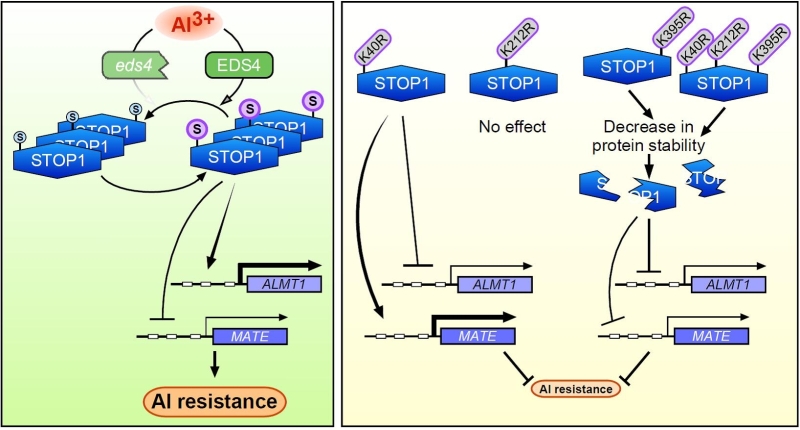A new layer of post-translational regulation on the aluminum-resistance transcription factor STOP1 discovered
Scientists at the Shanghai Center for Plant Stress Biology, Center for Excellence in Molecular Plant Sciences of the Chinese Academy of Sciences, have discovered that SUMOylation, a post-translational modification, is involved in the regulation of STOP1 and aluminum (Al) resistance in Arabidopsis thaliana. This study was published on October 21st, 2020 in Plant Cell.
Aluminum (Al) is a primary constraint for crop production on acid soils, which make up more than 30% of the arable land in the world. Plants have evolved resistance mechanisms to detoxify Al. Al resistance in Arabidopsis is achieved by malate secretion mediated by the AtALMT1 transporter. The C2H2-type transcription factor STOP1 is essential and required for Al resistance, where it acts by inducing the expression of Al-resistance genes, including AtALMT1. STOP1 protein has been reported to be regulated by ubiquitination, a type of post-translational modification. Nevertheless, it is unclear whether other post-translational modifications are involved in the regulation of STOP1.
Qiu Fang and colleagues in Chao-Feng Huang’s lab unraveled another layer of post-translational regulation of STOP1 by SUMOylation. They show that Al resistance can be modulated via a SUMO conjugation switch on the STOP1 transcription factor. STOP1 is mono-SUMOylated at the sites K40, K212, and K395, and deSUMOylated by the SUMO protease ESD4. This dynamic SUMOylation of STOP1 is involved in the control of the expression of downstream genes and Al resistance. Prevention of the ESD4-mediated deSUMOylation of STOP1 elevates STOP1 SUMOylation levels, which leads to the increased association of STOP1 with the AtALMT1 promoter and in turn leads to the increased expression of AtALMT1, ultimately enhancing Al resistance. Blocking of STOP1 SUMOylation, on the other hand, destabilizes STOP1 and causes reduced expression of STOP1-regulated genes and decreased Al resistance.
Funding: This work was supported by Shanghai Natural Science Foundation (Grant No. 20ZR1466500), National Natural Science Foundation of China (Grant No. 31570253 and 31870223 to C.-F. H.), the funding from Shanghai Center for Plant Stress Biology, Chinese Academy of Sciences, and National Key Laboratory of Plant Molecular Genetics.

Figure: Model for Regulation of STOP1 Function and Stability by SUMOylation
STOP1 is mono-SUMOylated at the three sites K40, K212 or K395 supposedly through the SUMOylation pathway. The STOP1 SUMOylation is reversible and can be deSUMOylated by the SUMO protease ESD4, which is increased in response to Al stress. Mutation of ESD4 elevates STOP1 SUMOylation levels and consequently increases and decreases the association of STOP1 with the promoters of AtALMT1 and AtMATE, respectively, which causes the increased AtALMT1 expression and the reduced expression of AtMATE and RAE1, and finally contributes to the increased Al resistance. Mutation of STOP1 SUMOylation site at K40 increases AtALMT1 and decreases AtMATE expression, which leads to reduced Al resistance. Mutation at K212 site does not affect STOP1 function and Al resistance. Blocking of STOP1 SUMOylation at K395 or all the three (K40, K212 and K395) sites reduces STOP1 protein level and the expression of AtALMT1 and AtMATE, leading to the decreased Al resistance.
Link to this article: https://doi.org/10.1105/tpc.20.00687